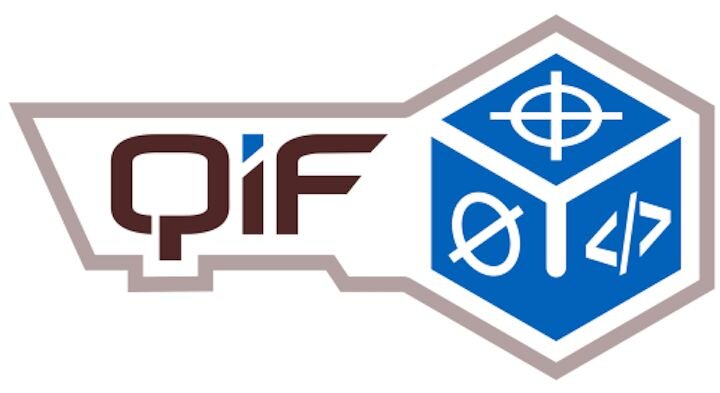
QIF Logo
I have a feeling we’re going to be seeing a lot more QIF in the future due to the rising use of 3D printing in manufacturing.
What Is QIF?
What’s that you say, you don’t know what QIF is? Well, I didn’t either until I looked it up and realized what was happening. QIF is an official ANSI standard for quality. QIF stands for “Quality Information Framework”.
Technically, it’s an XML definition for a large pile of data that can accompany a part in its manufacturing journey. That data is all about ensuring the quality of the part.
QIF is currently at release 3.0, and was developed by members of the Digital Metrology Standards Organization. It’s possible to obtain the entire 600-page standard document at no charge by registering.
You might be wondering what on Earth QIF could provide for you, and it turns out it’s quite a lot. The idea is to enable digital representation of all data required to perform and track quality measurements.
3D Print Quality Measurements
If you think about it, it’s actually quite a difficult problem. For a given part that must meet certain quality standards, these must be physically measured. But what, exactly, is to be measured? How is the measuring to take place? Under what conditions? What is the required tolerance level?
Given that manufactured objects can manifest in any conceivable geometry, the question of “what to measure” is a difficult one. Ultimately it will be determined by those expert in the design to ensure the factors “that count” are the required measurement points. But to maintain consistency of measurement, the tools and environmental conditions of measurement could also be specified. For example, a part should be measured at a particular temperature, otherwise its dimensions might be slightly different.
There’s also the matter of tracking the measurements. Who took them? Who is to take them? When were they taken? What were the results?
When you walk through what must happen during metrology, there is quite a lot happening, and that requires definition before, during and after the measurement process.
QIF attempts to define a standard by which all of this and much more can be digitally represented using standard XML mechanisms.
QIF Example
Here is a short excerpt from a sample QIF file, where you can get an idea of what is being described:
<Product> <PartSet n="1"> <Part hidden="false" id="1" transparency="0"> <ModelNumber>rev 1</ModelNumber> <Version>Version</Version> <DefinitionExternal id="6" n="2"> <PrintedDrawing id="5"> <Name>Drawing1</Name> <Version>1.0.0</Version> <Description>Sample QIF elements</Description> <DrawingNumber>#1</DrawingNumber> <AdditionalChanges>none</AdditionalChanges> <Location>Cabinet 17, Drawer 3</Location> </PrintedDrawing> <DigitalModel id="7"> <Name>Drawing1</Name> <File> <Name>D:\CM14_Parts\QIF\Drawing1.SLDPRT</Name> <Format> <DigitalModelFormatEnum>SOLIDWORKS</DigitalModelFormatEnum> </Format> </File> </DigitalModel> </DefinitionExternal> </Part> </PartSet> <ComponentSet n="1"> <Component hidden="false" id="2" transparency="0"> <Part> <Id>1</Id> </Part> </Component> </ComponentSet> <AsmPaths n="1"> <AsmPath id="3"> <ComponentIds n="1"> <Id>2</Id> </ComponentIds> </AsmPath> </AsmPaths> </Product> <Features> <FeatureDefinitions n="19"> <PlaneFeatureDefinition id="8"/> <PlaneFeatureDefinition id="20"/> <PlaneFeatureDefinition id="26"/> <CylinderFeatureDefinition id="35"> <InternalExternal>INTERNAL</InternalExternal> <Diameter>19</Diameter> </CylinderFeatureDefinition> <CircleFeatureDefinition id="50"> <InternalExternal>INTERNAL</InternalExternal> <Diameter>25.399999999999999</Diameter> </CircleFeatureDefinition> <CylinderFeatureDefinition id="61"> <InternalExternal>INTERNAL</InternalExternal>QIF suggests the following parties can make good use of the standard:
-
Metrologists: QIF can be used to transmit information between supply chain partners on how and what to measure, as well as communicate the results from the measurement.
-
PLM/PDM owner
s: QIF can be used to bring your quality information into the “digital thread” for your manufacturing operation and associate all your quality information directly to your master model. -
Metrology software implementers: QIF is an unambiguous, holistic, fully digital standard for metrology information. This will help software implementers, whether your organization is large or small in producing and/or consuming quality data.
QIF and Additive Manufacturing
My thought is that with the rapid increase in additive manufacturing taking place we will likely see an increased need for such standards. Parts produced using additive manufacturing are increasingly end-use parts, rather than prototypes, and thus they must meet specific quality standards.
One way of codifying the quality standards is through QIF, and thus we may see a lot more about QIF as time passes.
Via QIF
